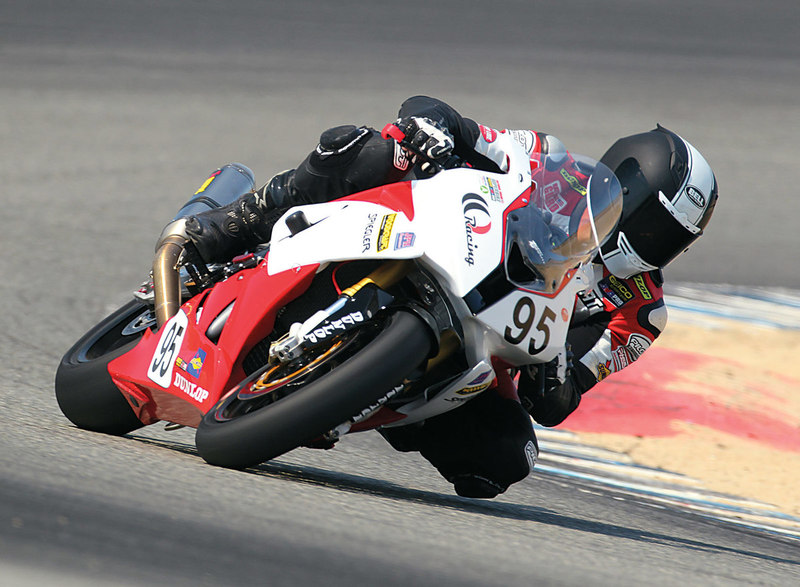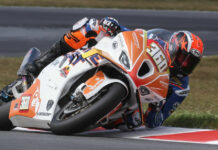Mathew Orange wanted to race motorcycles, and he wanted to do it badly. But in the real world, responsible people don’t get to just do whatever they want to do, whenever they want to do it. Orange laid a solid foundation, built up his business, bought a house, and raced two-wheeled vehicles without—shudder—motors until the time came that racing a motorcycle became a viable option. Since then, the road hasn’t been easy—there have been a lot of hard lessons in a very short time about what it means to be a motorcycle road racer. But Orange has clawed his way into the big show, qualifying for the AMA Pro Road Racing National Guard Superbike grid three times in 2013 and making plans for more in 2014. “I’ve been wanting to race motorcycles my whole life,” says Orange, 29, a general contractor out of Half Moon Bay, California. “And I don’t want to just make the show. I think I can run with the big boys.” Orange is a relative newcomer to the sport of performance riding. He’d messed around on other people’s dirt bikes, but the only motorcycle he’d owned up until 2008 was a 50cc Honda. Then, in 2008, he went to the MotoGP/AMA Pro Superbike event at Mazda Raceway Laguna Seca. Due to the death of his mother from leukemia when he was younger, Orange had been forced to mature quickly. He got the message about responsibility early. He knew that he’d have to lay a solid life foundation before playing with bikes. But by 2008, he’d purchased a house, had a business, and was an experienced downhill bicycle racer. It was time to chase the dream. Orange has always dreamed big, maybe because as a kid he was always borrowing his big brother’s bicycles. “I was always riding a bike that was too big for me,” he says. That may explain why his first motorcycle was a Yamaha YZF-R1. He rode it on the street for a few months, crashed it, put it back together, and had friends tell him he needed to take it to the racetrack. Orange took the advice. He signed up for his first track day in 2009 at what is now known as Sonoma Raceway, but had no intention of messing around or easing into anything—he simply wanted to know if life on the racetrack was going to work for him. Orange immediately found himself very, very comfortable riding on the track. “By 10:00 o’clock, I’d been kicked out of the C group,” he says. Orange soon started racing the YZF-R1 in Superstock trim with AFM. His first race with that organization took place that same year at Thunderhill Raceway Park. He recalls leading his first race until carpal tunnel damage from years of bodybuilding, construction and downhill bicycle racing left him unable to control the motorcycle properly; “It’s kind of scary when you can’t feel your fingers,” he says. The second time out—after surgery—Orange says, he won. Orange finished the season seventh in Novice Open Grand Prix and 10th in Novice Open Superbike. The next season, he was racing Expert Open Grand Prix and Open Superbike, notching top-10 finishes in each class against some of the fastest club competitors in the nation. But Orange found club racing didn’t give him what he was looking for. He was aghast at some of the money spent in the club racing paddock to win six-lap sprint races. It’s not atypical for the front-running Open-class racers at any club to go through multiple sets of tires in a weekend, let alone the cost of the machines, the race fuel, etc., he said. And six-lap races, or even races double that length, just didn’t appeal to Orange. “I don’t really believe in sprint races,” Orange says. “It’s about who has more guts than the other guy.” So Orange looked toward the AMA Pro series, where he thought he would be more comfortable. “The AMA has a certain set of rules. It feels like everyone takes it more seriously,” Orange says. And the much, much longer race format appealed to him. “You get to see real talent,” he says. Orange tried to qualify for his first AMA Pro race at Sonoma in 2012, but his bike had an engine problem during qualifying and he failed to make the grid. Undaunted, he bought a 2012 BMW S1000RR and headed for Daytona this year, where he also failed to make the grid. The advice he was getting on the bike’s settings made it all but unrideable, Orange said. He was trying to do too much on his own, and what help he had was actually making things worse. The same thing happened at Road America. “The set-up was so wrong. I was someone’s guinea pig, and … it just didn’t work out,” he said. “And I would come into the pits at Daytona, I was changing my own tires, I was a one-man show. It’s been a struggle, to say the least.” It would be enough to shake someone else’s confidence. But one of the unique characteristics of Orange is his confidence. Talk to him for a bit, and not only will he tell you that he has the ability to ride at the top level, but his tone of voice tells you that he is absolutely certain of it. Orange got some help from Öhlins in setting up the the bike, which would qualify for most Modified Production club-level classes. It’s got an Öhlins TTX shock, Öhlins gas-charged fork cartridges, a BMW kit ECU and a full Brembo braking system. With the new settings, the bike was transformed. Orange took it out for a track day at Mazda Raceway Laguna Seca and knew it was far better. When AMA Pro came to Laguna Seca for the MotoGP round in July, Orange put the bike 17th on the grid and finished 15th. Orange hit the road again and did the Miller Motorsports Park round, putting in a massive number of laps, qualifying 22nd and finishing 20th. And at the AMA Pro round at Laguna with World Superbike, Orange again qualified, this time 13th, 1.7 seconds faster than his qualifying time of a few months earlier, and finished 11th. Orange does indeed find the longer race formats more to his liking. “It’s more of a real race. I believe that it becomes more rider and less bike because it’s endurance. It’s not just physical endurance, but it’s mental endurance as well,” Orange says. “Everything changes after 15 laps. Everything goes away. But I have more fun when it starts sliding around. I progressively get faster. Toward the end, you’ll see 10ths of a second faster, faster, faster.” Orange is looking forward to 2014, and looking to build a proper race program that can put the bike solidly among the front-runners. “It’s the underdog bike. This one kind of feels like a 600 in handling—you can turn it easily, but it still has the power behind it,” Orange says. “I believe we’re able to get into the top-10 range before I really need engine work. We want to make it work properly. I’m watching the AMA guys, and they’re all talented, but I don’t believe that I couldn’t do that.”
ATHLETE FEATURE: Mathew Orange
ATHLETE FEATURE: Mathew Orange
© 2013, Roadracing World Publishing, Inc. By Michael Gougis.






